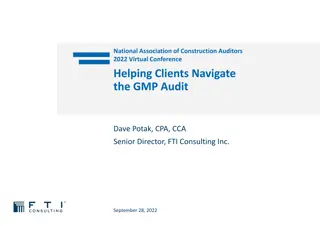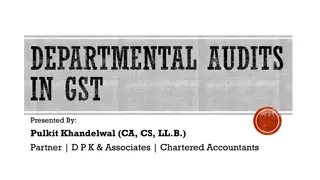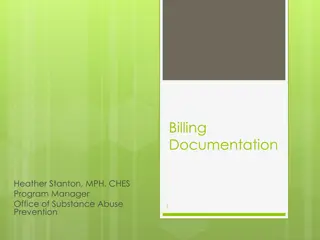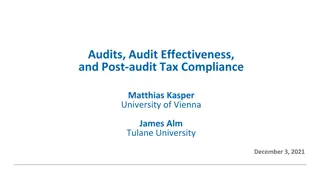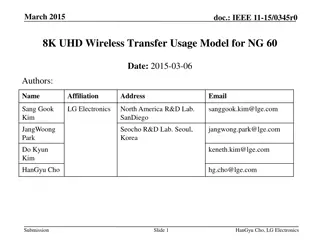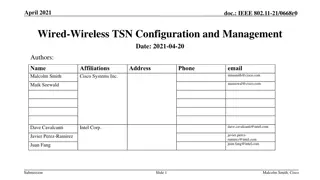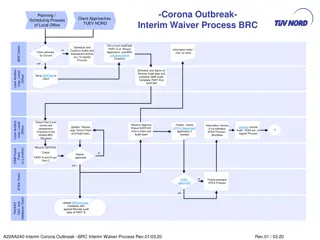Understanding Wireless Security Audits and Best Practices
Explore the world of security audits with a focus on wireless networks. Learn about the types of security audits, best practices, and the steps involved. Discover the importance of systematic evaluations, identifying vulnerabilities, establishing baselines, and compliance considerations. Dive into the tools used, such as RF coverage detectors, protocol sniffers, and offensive tools for auditing wireless layers. Enhance your understanding of security audits for robust network protection.
- Wireless Security Audits
- Network Vulnerabilities
- Systematic Evaluation
- Compliance Requirements
- Best Practices
Download Presentation

Please find below an Image/Link to download the presentation.
The content on the website is provided AS IS for your information and personal use only. It may not be sold, licensed, or shared on other websites without obtaining consent from the author. Download presentation by click this link. If you encounter any issues during the download, it is possible that the publisher has removed the file from their server.
E N D
Presentation Transcript
LM 10. Wireless Security Audit IT4833 Dr. Lei Li
Learning Objectives After this module, student will be able to: Explain what is security audit Identify the types of security audit Discuss the best practices for security audit Discuss the purpose of security audit Discuss the tools used for security audit 2
Security Audit Systematic evaluation of the security Identify security problems and gaps, as well as system weaknesses Establish a security baseline that future audits can be compared with Comply with internal organization security policies Comply with external regulatory requirements Determine if security training is adequate Identify unnecessary resources
Types of Security Audit Image source: https://searchcio.techtarget.com/definition/security-audit
Systems an Audit Cover Network vulnerabilities Security controls Encryption Software systems Architecture management capabilities Telecommunications controls Systems development audit Information processing
Steps Involved in a Security Audit Agree on goals Define the scope of the audit Conduct the audit and identify threats Evaluate security and risks Determine the needed controls
Test vs. Assessment vs. Audit An audit validation Test check a specific system Assessment a planned test
Wireless Security Audit Layer 1 Audit Layer 2 Audit WLAN Security Audit Wired Infrastructure Audit Social Engineering Audit Wireless Intrusion Prevention System (WIPS) Audit
Layer 1 & 2 Auditing Tool Layer 1 Audit determine RF coverage Layer 2 Audit detect rogue device Tools Protocol sniffers/analyzers (ex. Wireshark) 2.4/5 GHz signal injectors. Offensive tools (mdk3, Void11, Bugtraq, IKEcrack, FakeAP, etc.)
WLAN Security Audit Tool How a WLAN may be compromised Protocol sniffers/analyzers (ex. Wireshark). Wireless discovery tools (ex. NetStumbler, Kismet, Win Sniffer, WiFiFoFum, etc.). Encryption/Authentication breaking (testing) tools (aircrack-ng, custom scripts, all kinds of cryptoanalysis tools).
Wired Infrastructure Audit Inspection of the firewall used to restrict WLAN user access to certain network resources. Switchport interfaces that are unused should be disabled. A strong password should be used, and protocols with built-in encryption should be used (HTTPS, SSH), if possible.
Social Engineering Audit Uses non-technical approaches Security awareness campaigns
Wireless Intrusion Prevention Systems Detecting and preventing the usage of unauthorized wireless devices A set of dedicated passive sensors Image source: https://www.tutorialspoint.com/wireless_security/wireless_security_tools.htm
References https://searchsecurity.techtarget.com/IT-security-auditing-Best- practices-for-conducting-audits https://www.tutorialspoint.com/wireless_security/wireless_security _tools.htm







